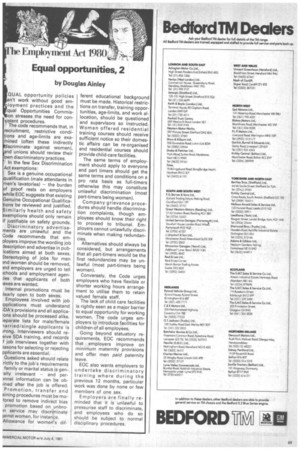Equal opportunities, 2
Page 43

If you've noticed an error in this article please click here to report it so we can fix it.
by Douglas Ainley QUAL opportunity policies n't work without good emloyment practices and the qual Opportunities Commis-, ion stresses the need for consistent procedures.
The code recommends that, in oecruitment, restrictive conditions and age-limits are exaMined (often these indirectly iscriminate against women), and unions should review their own discriminatory practices. In the few Sex Discrimination Act exemptions: Sex is a genuine occupational qualification (male attendants in men's lavatories) — the burden of proof rests on employers while EOC suggests that existing Genuine Occupational Qualificaions be reviewed and justified. imilarly health and safety xemptions should only remain if justifiable on safety grounds.
Discriminatory advertisements are unlawful and the Code recommends that employers improve the wording job description and advertise in pubications aimed at both sexes. Stereotyping of jobs for men ind women should be removed, md employers are urged to tell ;chools and employment agen:les that applicants of both ;exes are wanted.
Internal promotions must be :learly open to both sexes. Employees involved with job ipplications must understand ;DA's provisions and all applica
ions should be processed alike. leparate lists for male/female iarried/single applicants is rrong. Interviewers should reeive SDA training, and records f job interviews together with .asons for selecting or rejecting pplicants are essential. Questions asked should relate :rictly to the job's requirements family or marital status is gen-ally irrelevant — and per)nnel information can be ob:ined after the job is offered. Promotion, transfer and aining procedures must be motored to remove indirect bias promotion based on unbro,n service may discriminate iainst women, for instance. Allowance for women's dif
ferent educational background must be made. Historical restrictions on transfer, training opportunities, age-limits, and work allocation, should be questioned and supervisors so instructed. Women offered residential training courses should receive sufficient notice so their domestic affairs can be re-organised and residential courses should provide child-care facilities.
The same terms of employment should apply to everyone and part timers should get the same terms and conditions on a pro rata basis as full-timers otherwise this may constitute unlawful discrimination (most part-timers being women).
Company grievance procedures should handle discrimination complaints, though employees should know their right to proceed to tribunal. Employers cannot unlawfully discriminate when making redundancies.
Alternatives should always be considered, but arrangements that all part-timers would be the first redundancies may be unlawful (most part-timers being women).
Conversely, the Code urges employers who have flexible or shorter working hours arrangement to utilise them to retain valued female staff.
The lack of child care facilities is rightly seen as a major barrier to equal opportunity for working women. The code urges employers to introduce facilities for children of all employees.
Going beyond statuatory requirements, EOC recommends that employers improve on minimum maternity provisions and offer men paid paternity leave.
EOC also wants employers to undertake discriminatory training where during the previous 12 months, particular work was done by none or few members of one sex.
Employers are finally reminded that it is unlawful to pressurise staff to discriminate, and employees who do so should be subject to normal disciplinary procedures.












































